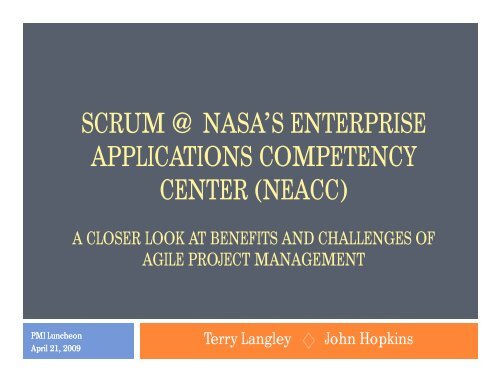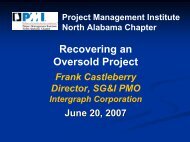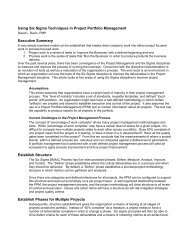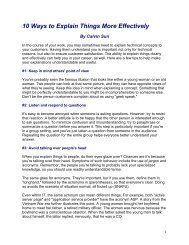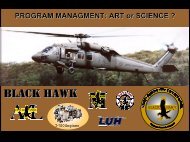scrum @ nasa's enterprise applications competency center (neacc)
scrum @ nasa's enterprise applications competency center (neacc)
scrum @ nasa's enterprise applications competency center (neacc)
Create successful ePaper yourself
Turn your PDF publications into a flip-book with our unique Google optimized e-Paper software.
SCRUM @ NASA’S ENTERPRISE<br />
APPLICATIONS COMPETENCY<br />
CENTER (NEACC)<br />
A CLOSER LOOK AT BENEFITS AND CHALLENGES OF<br />
AGILE PROJECT MANAGEMENT<br />
PMI Luncheon<br />
April 21, 2009<br />
Terry Langley<br />
John Hopkins
Summary Bios<br />
< 2 ><br />
Terry Langley<br />
<br />
<br />
<br />
<br />
NASA Lead for Software Assurance/Agile Process Support<br />
20+ Years in Software Systems Engineering including ERP Software<br />
NASA PP&E Deputy Project Manager<br />
Focus on Project Delivery, Strategic Initiatives, and Business Case Development<br />
John Hopkins<br />
<br />
<br />
<br />
<br />
<br />
11 Years in Software Development, Software Project Management, ERP Solutions<br />
Played key role in NASA EACC transition to Scrum and organizational change effort to<br />
support transition<br />
NASA UNITeS PP&E Project Manager & Quality Assurance Delivery Manager<br />
Certified Scrum Master (CSM)<br />
Project Management Professional (PMP)
“Agile” Has Come A Long Way...<br />
< 3 >
Talking Points<br />
< 4 ><br />
<br />
<br />
<br />
<br />
<br />
<br />
<br />
NASA Enterprise Applications Competency Center (NEACC) Overview<br />
Why Did We Change<br />
Why Scrum<br />
How Does Scrum Work<br />
How Did We Change<br />
Steps We Took from the Start<br />
Organizational Obstacles We Encountered<br />
Key Benefits Realized<br />
Results Summary<br />
Employee Perspectives<br />
Where are we today<br />
Scrum’s Compatibility with PMI & the PMBOK<br />
PMBOK’s Knowledge Areas & the Scrum Workflow<br />
How Does PMI Feel
NEACC Overview<br />
< 5 ><br />
<br />
Background:<br />
Located in Huntsville, AL<br />
Provides Agency-wide Enterprise Applications Support, IT Infrastructure Support, and<br />
Applications Development Services for the NASA Agency<br />
Provides functional and technical support to 11 Functional and Technical Lines of<br />
Business, spanning over 60 <strong>applications</strong><br />
Combination of NASA Civil Service and Contractors<br />
<br />
Vision: A modern, integrated business environment helping NASA achieve its<br />
strategic vision<br />
<br />
Mission: To improve financial, physical, and human capital management<br />
processes throughout the Agency – re-engineer NASA’s business infrastructure<br />
using industry “best practices” and deploy enabling technology to provide<br />
management information needed to implement the Agency’s Strategic Plan<br />
<br />
Purpose: To transform business systems and processes to improve NASA’s fiscal<br />
and management accountability
Why Did We Change<br />
< 6 ><br />
We weren’t discovering the customer’s ‘real’<br />
requirements until it was too late<br />
We never had enough time to perform adequate<br />
testing<br />
The internal customers were not happy with the<br />
systems we delivered<br />
The work environment wasn’t fun and creative<br />
We weren’t moving towards our vision<br />
Something was “missing” – there had to be a better<br />
way
Why Scrum<br />
< 7 ><br />
<br />
<br />
<br />
<br />
<br />
In 2006, vendor challenges coupled with inadequate testing of unclear<br />
requirements created an impetus for change<br />
Familiar with the concept of rapid/iterative development, the NASA<br />
Software Assurance Manager sought out a better approach<br />
Scrum surfaced as an alternative after several months of research. The<br />
Scrum process was intriguing and seemed attractive because of its core<br />
tenets:<br />
Close interaction with the user<br />
Co-location of cross functional teams<br />
Shorter development iterations<br />
Quicker turnaround time to produce working software<br />
Higher quality of software delivered leads to less post-release defects<br />
The decision was made to pilot the Scrum process on a small project, and<br />
early results demonstrated positive results; however “ugly warts”<br />
surfaced which needed attention<br />
Within several months, Scrum became the de facto standard process for<br />
NEACC projects and remains the standard today
8 ><br />
How Does Scrum Work<br />
Process Overview<br />
Key Practices<br />
Self-directed; self-organizing teams<br />
(preferably co-located)<br />
Iterative Adaptive planning<br />
Stakeholder/Customer<br />
Involvement<br />
30-calendar day iterations<br />
15 minute daily stand-up meeting<br />
Team measures progress daily<br />
Each iteration delivers tested,<br />
fully-functional software for<br />
demonstration<br />
Always 30-days from<br />
potential production release<br />
Sprint Retrospective Process<br />
Create a rhythm and flow<br />
© Agile Infusion, LLC 2007-2009
9 ><br />
How Did We Change<br />
Steps We Took From the Start<br />
<br />
<br />
<br />
<br />
It starts with a champion<br />
A change agent is necessary for Scrum to succeed<br />
Got buy-in for use of Scrum from Competency Center Director<br />
Change in culture is so drastic that you need to have commitment from<br />
top levels<br />
Worked with Building Manager to create Scrum rooms<br />
Cubicles hinder open communication and teamwork<br />
Engaged a ‘Scrum Coach’<br />
Offered basic Scrum training<br />
Provided training for Product Owners<br />
Certified Scrum Masters<br />
Took some of the bullets for us which helped teams gel<br />
Coach continues to monitor teams periodically and suggest areas for<br />
improvement
10><br />
How Did We Change<br />
Organizational Obstacles We Encountered<br />
<br />
<br />
<br />
<br />
<br />
<br />
<br />
Difficulty in educating all teams on Scrum process and<br />
principles (change in traditional thinking)<br />
Dominant personalities & role of ‘hero’<br />
Destructive behaviors (willingness to adopt Scrum/self<br />
direction)<br />
Resource pooling limitations<br />
Insufficient product backlog management (stay away from<br />
‘geek speak’, utilize user stories’ instead)<br />
Poor grasp of team velocity & over commitment tendency<br />
Managers can micro-manage & may lack trust - trust in<br />
employee judgment can be lacking in some cases
11><br />
Key Benefits Realized<br />
Results Summary<br />
Greater accuracy and understanding of user needs<br />
through frequent interaction and regular<br />
checkpoints (Sprint reviews)<br />
Customers are excited about their new level of<br />
involvement<br />
Teams are better equipped to estimate cost &<br />
schedule<br />
Team members are more engaged and have a new<br />
level of commitment to their work & teammates<br />
Higher quality of delivered products and services –<br />
less defects prior to release; fewer bugs and change<br />
requests post-release<br />
Collected metrics which quantified the results
12><br />
Key Benefits Realized<br />
Results Summary – Scrum Works!<br />
Project W1, Project W2, Project S1<br />
Relative Comparison of All Defects to Tests Executed<br />
0.80<br />
0.70<br />
0.70<br />
Defects to Tests Executed<br />
0.60<br />
0.50<br />
0.40<br />
0.30<br />
0.20<br />
0.41 0.41<br />
0.29<br />
0.18<br />
0.42<br />
0.35<br />
0.22<br />
0.20<br />
0.15 0.14 0.15<br />
0.10<br />
0.00<br />
SIT 1 SIT 2 SIT 3 Total<br />
Project W1 Project W2 Project S1<br />
When looking at total defects logged, 2 traditional projects had total defect to test ratios of .35 & .42<br />
respectively, whereas the Scrum project had a ratio of .15
13><br />
Key Benefits Realized<br />
Results Summary – Scrum Works!<br />
Project W1, Project W2, Project S1<br />
Relative Comparison of All Very High & High Defects to Tests Executed<br />
0.35<br />
0.30<br />
0.31<br />
Defects to Tests Executed<br />
0.25<br />
0.20<br />
0.15<br />
0.10<br />
0.05<br />
0.00<br />
0.20<br />
0.19<br />
0.15<br />
0.14<br />
0.13<br />
0.06 0.06<br />
0.01 0.01<br />
0.01 0.01<br />
SIT 1 SIT 2 SIT 3 Total<br />
Project W1 Project W2 Project S1<br />
When comparing the total Very High & High defects, 2 traditional projects had ratios of .19 & .13<br />
respectively, whereas the Scrum project had a ratio of .01!
14><br />
Key Benefits Realized<br />
Results Summary – Scrum Works!<br />
Project W1, Project W2, Project S1<br />
Relative Comparison of Cumulative Defects/Service Requests Post Go-Live<br />
Total Defects/Service Requests Post Go-Live<br />
450<br />
400<br />
350<br />
300<br />
250<br />
200<br />
150<br />
100<br />
50<br />
0<br />
389<br />
363<br />
313<br />
228<br />
244<br />
190<br />
128<br />
129<br />
86<br />
Go Live +30 Days Go Live +60 Days Go Live +90 Days<br />
Project W1 Project W2 Project S1<br />
After Go-Live, Defect/Service Request ticket counts for Project W1 and W2 outpaced Project S1 by more<br />
than 2 to 1 and 1.9 to 1, respectively.
The “Unofficial” One Word Employee Survey….<br />
< 15><br />
Uniting<br />
Discipline<br />
Thumbs-up<br />
Change<br />
Innovative<br />
Integration<br />
Focused<br />
Fast-Paced<br />
Awesome<br />
Tough<br />
Complex<br />
Scrumtruescent<br />
Policies<br />
Challenging<br />
Effective<br />
Accountability<br />
Believer<br />
Communication<br />
Organized<br />
Enlightening<br />
Team-Building<br />
Flexibility<br />
So-So
16><br />
Key Benefits Realized<br />
Where are we today<br />
<br />
<br />
<br />
<br />
<br />
<br />
Most major NEACC initiatives since Fall 2006 have utilized<br />
Scrum<br />
Scrum is gaining visibility throughout the Agency<br />
Utilization of Scrum has not been limited to software<br />
development efforts<br />
Scrum principles are being applied to strategic focus areas<br />
across the program<br />
Emphasis on cross-functional collaboration is key<br />
Time-boxed iterations help to frame what can be<br />
accomplished in a given time period
Scrum’s Compatibility with PMI & the PMBOK<br />
Can the two work together
Is Scrum Compatible with PMI & the PMBOK<br />
< 18 ><br />
Sprint<br />
Planning<br />
DO<br />
Plan-Do-Check-<br />
Act<br />
Daily<br />
Obstacles<br />
Removed<br />
Sprint Review<br />
<br />
<br />
Scrum projects should utilize<br />
the 9 Core PMI Knowledge<br />
Areas and 5 Project Phases<br />
Scrum workflow fits nicely<br />
with Deming’s PDCA model<br />
Release<br />
Backlog<br />
PLAN<br />
Product<br />
Roadmap<br />
Business<br />
Goals<br />
ACT<br />
CHECK<br />
Planning /<br />
Retrospective<br />
<br />
Generates useful knowledge<br />
to continually improve<br />
Process<br />
Product<br />
People<br />
Some content copyright of Bob Schatz of Agile Infusion, LLC (http://www.agileinfusion.com)
How Does PMI Feel<br />
A Perspective from Gregory Balestrero (PMI CEO)<br />
< 19><br />
<br />
<br />
<br />
<br />
<br />
“There is no question that agile PM is a leading and emergent practice. It has<br />
great traction in software development and software installation. It is now moving<br />
into mainstream activities such as manufacturing in the telecommunications<br />
field.”<br />
“…on the Scrum side, there was the perception that ‘the PMI way is incompatible<br />
with agile.’ And there is also a misperception that PMI "methodology" pushes<br />
against the movement of speed and agility in PM. Both sides of the proverbial<br />
fence share misunderstandings that needed correction. “<br />
“…the PMBOK® Guide, at least the 4 th edition, is compatible with iterative<br />
planning, scalable WBS, etc. Yet, the misperceptions exists.”<br />
“The issue that gets in the way of an agile approach seems less the issue of the<br />
PMBOK® Guide, but more the issue of organizational culture. “<br />
“Maybe, just maybe, there should be strategic principles and values that address<br />
management style, instead of viewing management, and in particular project<br />
management as a tactical approach for which someone else is responsible. “<br />
Content extracts from “A CEO’s Perspective on Project Management”, Gregory Balestrero, PMI CEO<br />
(http://blogs.pmi.org/blog/a_chief_executives_perspective_on_project_management/2009/03/on-the-threshold-of-agility.html)
Contact Information<br />
< 20><br />
Terry Langley<br />
Email: terry.s.langley@nasa.gov<br />
John Hopkins<br />
Email: john.j.hopkins@saic.com
Reference Sources<br />
< 21><br />
• Agile Project Management with Scrum – Ken Schwaber<br />
• Agile Estimating and Planning – Mike Cohn<br />
• User Stories Applied: For Agile Software Development –<br />
Mike Cohn<br />
• http://www.<strong>scrum</strong>alliance.org/
Questions & Open Discussion


